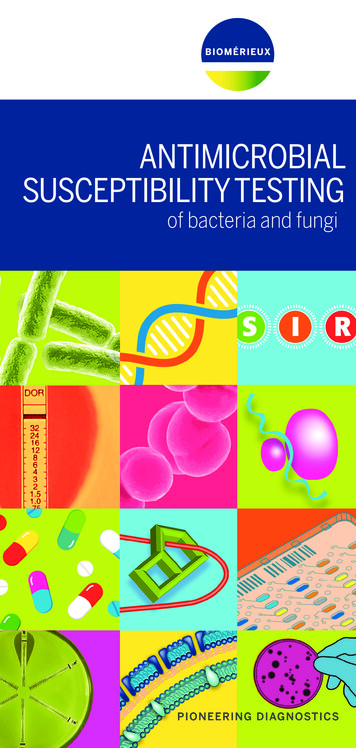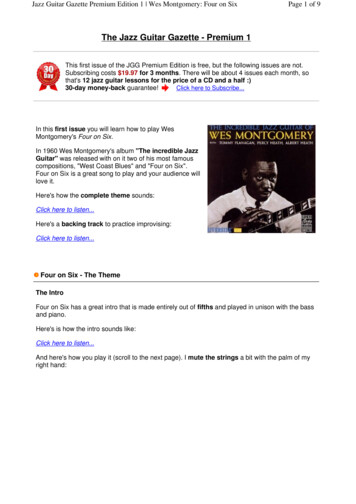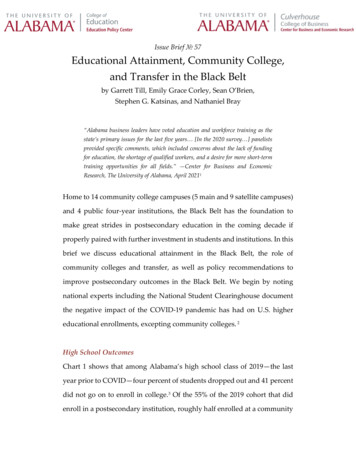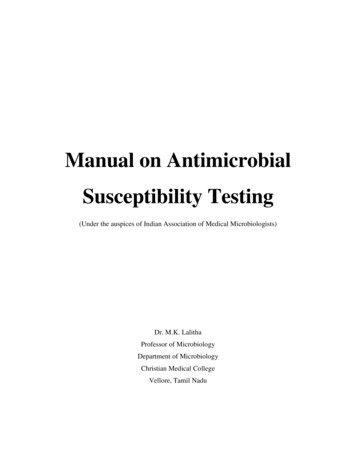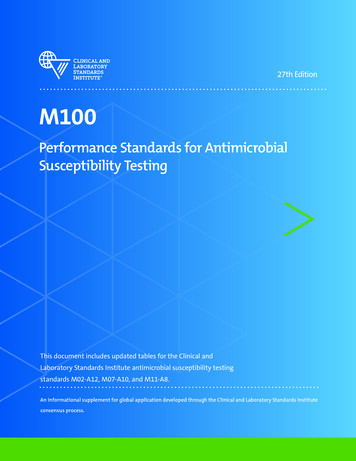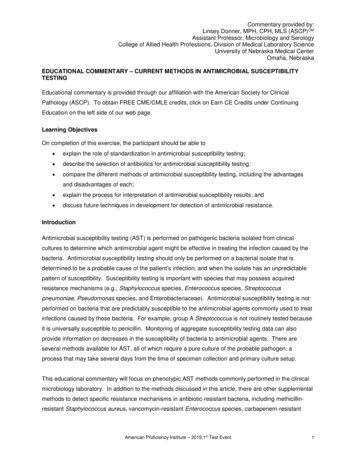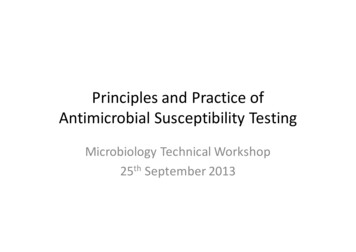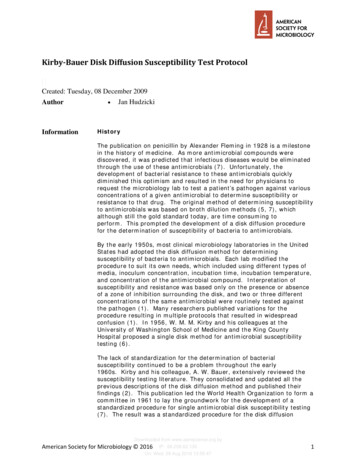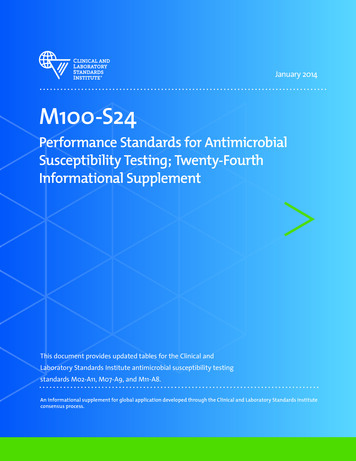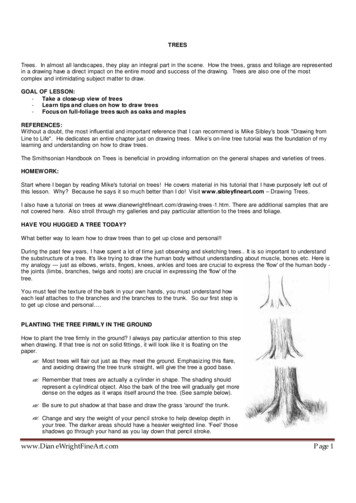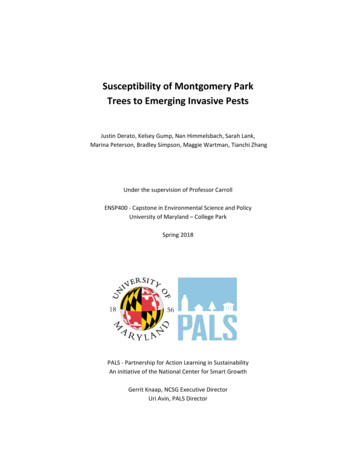
Transcription
Susceptibility of Montgomery ParkTrees to Emerging Invasive PestsJustin Derato, Kelsey Gump, Nan Himmelsbach, Sarah Lank,Marina Peterson, Bradley Simpson, Maggie Wartman, Tianchi ZhangUnder the supervision of Professor CarrollENSP400 - Capstone in Environmental Science and PolicyUniversity of Maryland – College ParkSpring 2018PALS - Partnership for Action Learning in SustainabilityAn initiative of the National Center for Smart GrowthGerrit Knaap, NCSG Executive DirectorUri Avin, PALS Director
Table of ContentsExecutive Summary . . . . . . . . . . . . . . . . . . . . . . . . . . . . . . . . . . . . . . . . . . . . . . . . . . . . . . . . . . . . . . . . . . . . 2Description of Problem . . . . . . . . . . . . . . . . . . . . . . . . . . . . . . . . . . . . . . . . . . . . . . . . . . . . . . . . . . . . . . . . . 3Key Goals and Objectives . . . . . . . . . . . . . . . . . . . . . . . . . . . . . . . . . . . . . . . . . . . . . . . . . . . . . . . . . . . . . . . 3Background Research . . . . . . . . . . . . . . . . . . . . . . . . . . . . . . . . . . . . . . . . . . . . . . . . . . . . . . . . . . . . . . . . . .Emerald Ash Borer: A Case Study for Invasive Species Management . . . . . . . . . . . . . . . . . . . . . . . . . .Pest Background and Hosts . . . . . . . . . . . . . . . . . . . . . . . . . . . . . . . . . . . . . . . . . . . . . . . . . . . . . . . . . . . .Asian Longhorned Beetle (ALB) . . . . . . . . . . . . . . . . . . . . . . . . . . . . . . . . . . . . . . . . . . . . . . . . . . . . .Spotted Lanternfly (SLF) . . . . . . . . . . . . . . . . . . . . . . . . . . . . . . . . . . . . . . . . . . . . . . . . . . . . . . . . . . .Oak Wilt (OW) . . . . . . . . . . . . . . . . . . . . . . . . . . . . . . . . . . . . . . . . . . . . . . . . . . . . . . . . . . . . . . . . . . .Thousand Cankers Disease (TCD) . . . . . . . . . . . . . . . . . . . . . . . . . . . . . . . . . . . . . . . . . . . . . . . . . . . .4455678Risk Equation Methods . . . . . . . . . . . . . . . . . . . . . . . . . . . . . . . . . . . . . . . . . . . . . . . . . . . . . . . . . . . . . . . . 11Host Tree Susceptibility . . . . . . . . . . . . . . . . . . . . . . . . . . . . . . . . . . . . . . . . . . . . . . . . . . . . . . . . . . . . . . 11Risk Equation . . . . . . . . . . . . . . . . . . . . . . . . . . . . . . . . . . . . . . . . . . . . . . . . . . . . . . . . . . . . . . . . . . . . . . 15ArcGIS Methods and Map Creation . . . . . . . . . . . . . . . . . . . . . . . . . . . . . . . . . . . . . . . . . . . . . . . . . . . . 18ArcGIS: Park Diversity Value (PDV) . . . . . . . . . . . . . . . . . . . . . . . . . . . . . . . . . . . . . . . . . . . . . . . . . . 18ArcGIS Total Park Risk . . . . . . . . . . . . . . . . . . . . . . . . . . . . . . . . . . . . . . . . . . . . . . . . . . . . . . . . . . . . 20ArcGIS Total Risk Sample: Asian longhorned beetle (ALB) . . . . . . . . . . . . . . . . . . . . . . . . . . . . . . . 20Montgomery Parks Online Web Application . . . . . . . . . . . . . . . . . . . . . . . . . . . . . . . . . . . . . . . . . . . . . 23Risk Analysis Results . . . . . . . . . . . . . . . . . . . . . . . . . . . . . . . . . . . . . . . . . . . . . . . . . . . . . . . . . . . . . . . . . . 23Economic Risk Analysis . . . . . . . . . . . . . . . . . . . . . . . . . . . . . . . . . . . . . . . . . . . . . . . . . . . . . . . . . . . . . . . 27Final Recommendations . . . . . . . . . . . . . . . . . . . . . . . . . . . . . . . . . . . . . . . . . . . . . . . . . . . . . . . . . . . . . . .General Strategies for Montgomery Parks . . . . . . . . . . . . . . . . . . . . . . . . . . . . . . . . . . . . . . . . . . . . . . .Pest Specific Management Strategies . . . . . . . . . . . . . . . . . . . . . . . . . . . . . . . . . . . . . . . . . . . . . . . . . . .Asian Longhorned Beetle (ALB) . . . . . . . . . . . . . . . . . . . . . . . . . . . . . . . . . . . . . . . . . . . . . . . . . . . .Spotted Lanternfly (SLF) . . . . . . . . . . . . . . . . . . . . . . . . . . . . . . . . . . . . . . . . . . . . . . . . . . . . . . . . . .Oak Wilt (OW) . . . . . . . . . . . . . . . . . . . . . . . . . . . . . . . . . . . . . . . . . . . . . . . . . . . . . . . . . . . . . . . . . .Thousand Cankers Disease (TCD) . . . . . . . . . . . . . . . . . . . . . . . . . . . . . . . . . . . . . . . . . . . . . . . . . . .Project Limitation Recommendations . . . . . . . . . . . . . . . . . . . . . . . . . . . . . . . . . . . . . . . . . . . . . . .3030313131323233Conclusion . . . . . . . . . . . . . . . . . . . . . . . . . . . . . . . . . . . . . . . . . . . . . . . . . . . . . . . . . . . . . . . . . . . . . . . . . . 33References . . . . . . . . . . . . . . . . . . . . . . . . . . . . . . . . . . . . . . . . . . . . . . . . . . . . . . . . . . . . . . . . . . . . . . . . . . 35Appendix . . . . . . . . . . . . . . . . . . . . . . . . . . . . . . . . . . . . . . . . . . . . . . . . . . . . . . . . . . . . . . . . . . . . . . . . . . . 39Appendix I. ArgGIS Methods . . . . . . . . . . . . . . . . . . . . . . . . . . . . . . . . . . . . . . . . . . . . . . . . . . . . . . . . . . 39Appendix II. ArcGIS Maps . . . . . . . . . . . . . . . . . . . . . . . . . . . . . . . . . . . . . . . . . . . . . . . . . . . . . . . . . . . . . 601
Executive SummaryThis report provides recommendations to the Montgomery County Department of Parks on themanagement of four invasive pests: Asian longhorned beetle (Anoplophora glabripennis), spottedlanternfly (Lycorma delicatula), oak wilt, and thousand cankers disease in managed park regions. Toprepare for these potential infestations, an analysis of the risk to current park tree populations wasperformed using unique spatial and tree data characteristics. Additionally, a comprehensive interactivetoolkit that provides park staff with information on best management practices was developed.Researching the PestsTo evaluate risk of each pest, literature was reviewed to identify host species, relevant life history traits,and possible management strategies applicable to Montgomery Parks. The host species for each pest wasthen overlaid with a list of managed trees species to identify host species important for the finalrecommendations. Pest characteristics were considered when developing pest specific managementstrategies. General information on increasing park resiliency was also explored to propose the mosteffective management strategies.Designing the EquationTo produce meaningful pest risk values for each park, a novel risk equation was designed using an arrayof current pest risk assessments. It utilizes a parameter of diversity, representing ecosystem resiliency, aswell as a weighted measure of the host species’ biomass available to each pest. The final risk values arethen incorporated into ArcGIS to generate risk maps for the county.Using ArcGISThe intended function of the ArcGIS web application is to provide the Montgomery County Departmentof Parks management staff and administration with a detailed tree inventory analysis. The module isequipped with a mapped tree inventory complete with park statistics such as diversity, total tree count,species distribution and a risk value for each pest of concern. This tree inventory can be viewed on aspatial scale, allowing for visual representation of park and tree data across the county within variousenvironmental management regions. The data is also intended to model risk susceptibility for fourinvasive pests within the region. This data can assist Park staff with mitigation planning and in developingan effective response to a spread of these specific pests. While it is intended for professional use, otherfunctions can be added for public access to report potential sightings and include general informationabout invasive pests in urban parks.Ecosystem Service AnalysisTo inform future management actions, potential ecosystem services lost for each high risk host specieswere calculated. Results assigned a monetary value for each tree species based on mean treecharacteristics provided by the Parks department. A general benefit evaluation of all the trees inventoriedin Montgomery County parks was also generated using the iTree database.2
Description of ProblemInvasive pests can threaten the health of urban forests and can cause significant environmental damageto parks. This project addresses four invasive pests that have the potential to enter Montgomery Countyin the near future. The pests of major concern to the Montgomery County Department of Parks includethe Asian longhorned beetle, spotted lanternfly, oak wilt, and thousand cankers disease. Modeling thespread of invasive pests through spatial analysis and GIS methods can provide valuable insight for Parkmanagement staff. The development of a tree risk susceptibility model based on various attributes suchas park biodiversity and host sensitivity allow for quantitative risk analysis leading to effective and timelymitigation strategies.Key Goals and ObjectivesGoal 1: Produce a comprehensive toolkit for each pest, including strategies for preventing and mitigatinginfestation, history of spread, and relevant supporting information.Rationale: By synthesizing scientific literature and the management strategies of other locales,the toolkits will provide Montgomery Parks with contemporary recommendations for managingeach pest of concern. These will be delivered concisely to make the management planning processmore efficient for Montgomery Parks.Objectives: Characterize the pest species, the history of their spread, and the damage and symptomsthey cause in host trees. Identify environmental, spatial, and tree property characteristics that will influence thespread and susceptibility of trees found within the parks. Compile promising management strategies from scientific studies and establishednational and state management plans.Goal 2: Create a risk equation to quantitatively assess park diversity and pest susceptibility based on adefined set of parameters from tree inventory data.Rationale: Susceptibility of the parks to Asian longhorned beetle, spotted lanternfly, oak wilt, andthousand cankers disease can be predicted based on the initial park diversity and abundance ofhost trees. Research from Goal 1 can be used to identify host species and their level ofsusceptibility to each pest. Using this information and the tree inventory data from MontgomeryParks, the susceptibility of tree species and forests within the parks can be generally estimated.Objectives:3
Determine host tree species for each pest under study.Assign each host species a risk factor value for each pest (scale 1-3).Goal 3: Develop interactive maps that identify areas at risk for Asian longhorned beetle, spottedlanternfly, oak wilt, and thousand cankers disease infestation within Montgomery Parks.Rationale: Visuals will be presented in the form of an online interactive map providing insight torisk susceptibility of four invasive pests based on park diversity and weighted host species cover.Objectives: Spatially analyze unique park diversity and tree susceptibility values across MontgomeryPark management regions. Apply GIS methods to park and tree risk through weighted factor quantification known asRisk Terrain Modeling (RTM). Deliver an ArcGIS Online tree inventory application with park and tree risk for each pestof interest within Montgomery County Parks.Goal 4: Analyze the ecosystem services provided by at-risk trees.Rationale: To help determine which parks or tree species should be prioritized, a cost analysis wasconducted for host species.Objectives: Quantify the tree value based on the structural and function approach. Determine the potential loss caused by the invasive species without appropriatemanagement.Background ResearchEmerald Ash Borer: A Case Study for Invasive Species ManagementInvasive pest species have become a considerable concern for forests in the United States. With the riseof international trading and traveling, humans are accidentally introducing non-native pests from all overthe world. Indigenous insects and fungi typically pose little or no threat to forest ecosystem function.However, the introduction of host-specific invasive pests can dramatically alter the composition of nativeforests. Such alterations are exacerbated when the pest’s host species comprises a significant portion ofa forest’s biomass. For instance, ash trees make up a significant portion of forests in the central andeastern U.S. and the introduction of the emerald ash borer (Agrilus planipennis) caused major changes inforest community assemblages (BenDor et al., 2006). Since its initial introduction in 2002, the emeraldash borer (EAB) has spread to 31 states and caused five species of ash to be “Critically Endangered” (USDA,4
2018; Carrington, 2017). The EAB spread quickly across the U.S. and park managers are desperate to findways to manage current infestations and prevent future spread to preserve native ash trees. The EAB andits management attempts can serve as a case study to prevent or manage other potential invasive pests.Managing current populations of an invasive pest relies heavily on detecting infestations early andimplementing aggressive control methods. Early detection of invasive pests like the EAB allows forestmanagers to stop an infestation before it grows uncontrollably large. Once detected, infestations can becontrolled through pesticide application and eradication procedures. These control methods are effectivefor managing EAB but are extremely costly—federal and state resource managers spent 25 billion totreat, remove, and replace nearly 40 million ash trees in urban areas (USDA, 2018).Preventing invasive pest spread can be achieved through federal quarantines, public outreach, andrisk models. Federal quarantines can be used to regulate the transport of host tree material, preventingaccidental introductions through infected wood. Another way to prevent accidental introductions is toincrease public awareness of invasive species and common signs of infestations. While quarantines andoutreach can help prevent introductions, risk models show promise in helping predict the spread ofinvasive pests and prompt forest managers to implement more aggressive management strategies. Forestmanagers can use tree survey data and tree susceptibility to model the risk a pest poses to their parksbased on the tree species they target.Pest Background and HostsWhen trying to identify successful management options for invasive pests, it is important to be aware oftheir life histories and biology. This information provides insight into formulating ways to manage aspecies. Here, we have species-specific general information about each pest studied for this project.Asian Longhorned Beetle (ALB)Life History: The Asian longhorned beetle (ALB) is a wood-boring beetle in the Cerambycidae family nativeto China and the Korean peninsula. In its adult stage this insect is from 1 to 1.5 inches long and possesslong antennae. ALB has four general life stages: egg, larvae, pupa, and adult (USDA APHIS “ALB - About”).Its first outbreaks were identified in China in the 1980s, linked to a project that introduced manyapplicable ALB host trees to the area. In 1992, ALB was beginning to spread via trade routes through woodpackaging. This beetle is now seen in North America as well as Europe (Haack et al., 2010).Host Trees of Significance: Throughout ALB’s entire life cycle, it feeds on a wide range of hardwood trees.These include: Acer (Maple), Aesculus (Buckeye), Betula (Birch), Koelreuteria paniculata (Golden RainTree), Platanus (Plane Tree), Albizia julibrissin (Persian Silk Tree, Salix (Willow Tree), and Ulmus (Elm Tree)(Sawyer, 2010; USDA APHIS “ALB - About”; Massachusetts Department of Agricultural Resources; Parker,2012; Invasive Species Centre, 2015).Damage: Signs of ALB emerge between 3 to 4 years after infestation of the tree. The tree dies over thenext 10 to 15 years. Once a tree is infected, it cannot recover or regenerate. Signs include exit holes, egg5
sites, frass (sawdust), tunneling, weeping sap (flow from wounds or egg sites), unseasonable yellow leaves(stress), and branches dropping or dying (USDA APHIS “ALB - About”).Dispersal Methods: When female beetles are ready to produce, they lay eggs beneath the bark of hosttrees. Larvae then bore into the hardwood tree and feed on the tissues that provide the tree withnutrients. After many weeks, larvae tunnel into and continue to feed on tree tissues to develop overwinter. As larvae feed, they form tunnels or galleries in tree trunks and bases. They tunnel into the growinglayers (phloem and cambium), and eventually into the woody tree tissue (xylem). Trees infested withlarvae can be identified by frass, a sawdust-like material, found at the trunk or branch bases. Frass is aproduct of the insect’s burrowing. Over a year, the larvae develop into adults. After the adults emerge,they chew their way out of the tree, leaving exit holes about ⅜-inches wide. They then feed on the tree’sleaves and bark for 10 to 14 days before mating and laying eggs. Adult females chew about 90 ovaldepressions (oviposition sites) and lays one egg beneath the bark at each. Adults can emerge at differenttimes because the insect can overwinter in many life stages. This results in feeding, mating, and layingeggs throughout summer and fall.Adult beetle activity takes place primarily in the summer and early fall, but adults have been seenfrom April until December. Adults usually remain on the tree from which they emerged; resulting ininfestation for many generations. However, they can fly 400 yards or more to find a tree or mate (USDAAPHIS “ALB - About”).Known Occurrences within the United States: ALB has been introduced in New York, Massachusetts,Ohio, Chicago, Illinois, New Jersey, California, Florida, Hawaii, Indiana, Michigan, North Carolina, Texas,Washington, and Wisconsin (University of Vermont “ALB Frequently Asked Questions”). Infestations inthese areas are limited in size with eradication possible. Current quarantines include New York,Massachusetts, and Ohio (USDA APHIS “ALB - Quarantines”). A few regulated areas in New York (in 2011and 2013), Chicago (2008), New Jersey (2013), and Canada (2013) have eradicated the pest viaquarantines.Spotted Lanternfly (SLF)Life History: The Spotted Lanternfly, Lycorma delicatula, is an invasive planthopper native to China thathas recently been reported in the United States (Order Hemiptera, Family Fulgoridae). An adult spottedlanternfly (SLF) will grow to around 1-inch long and have visibly striking spots along its forewings.Host Trees of Significance: The diet of SLF consists of primarily Ailanthus altissima (tree of heaven), andVitis vinifera (grapevine), however its known diet extends to a range of fruit producing trees and shrubssuch as apple, apricot, maple, and plum trees, as well as hops and almonds. SLF is known for its affinityfor hosts with a high sugar (sucrose and fructose) content (Dara et al., 2015; PDA, 2018).Damage: Damage to host species is caused mainly by feeding from both nymph and adult. Feeding on theleaves reduces photosynthesis, weakening the plant. Additionally, consumption causes the plant to ooze6
and weep sap, inhibiting water and nutrient transport. Prolonged inhabitation of SLF on a plant leads tomortality of that plant (APHIS, 2014).Dispersal Methods: Eggs are laid on smooth surfaces, of both natural and artificial origin. Eggs hatch inlate spring through early summer and nymphs immediately start feeding by sucking sap, on any availablespecies (Dara et al., 2015). Nymphs are agile and can climb up trees as soon as they emerge from egg. SLFuses its straw-like mouthpart to pierce the phloem tissues of plant’s stem and leaves. Sap is removedthrough a sucking mechanism. When feeding, SLF secretes honeydew that further inflicts sap-saturatedwounds. Exposed sap and honeydew contribute to the growth of sooty mold underground, which thenattracts other insects such as bees, hornets, wasps, and ants that feed on the plant (APHIS, 2014).Known Occurrences within the United States: Spotted lanternfly was first reported in the United Statesin Pennsylvania in 2014. By 2017, the range expanded across Pennsylvania and into Delaware and NewYork. Most recently, in January of 2018, SLF was reported and confirmed in Virginia. SLF is expected toarrive in Maryland by April 2018.Oak Wilt (OW)Life History: The pathogen responsible for oak wilt (OW) is a fungus called Ceratocystis fagacearum. Inred oaks, the fungus produces pressure cushions that push the bark away from the wood, forming cracks.Fungal mats then form in these cavities. Chemical compounds released by the fungal mat may be detectedseveral meters away from an infected tree and are responsible for the sweet fragrance that attracts beetlevectors (Juzwik et al., 2011). The origin of oak wilt is unknown; however it is generally believed to be nonnative to the United States. Evidence indicates that it most likely originated in Mexico, Central America,or northern South America and that it arose from a single introduction (Juzwik et al., 2008).Host Trees of Significance: The oak wilt fungus infects oak species (Quercus spp.). Red oaks display thehighest susceptibility to the disease. White oaks are the most resistant. Live oak susceptibility falls inbetween that of red and white (Koch et al., 2010).Damage: The fungus invades the vascular system of the host species and clogs the xylem. This hinders thetransport of water and nutrients throughout the tree, which leads to leaf browning, wilting, branchdieback, canopy loss, leaf drop, and mortality. Red oaks generally develop symptoms within a few weeksand die within a few months after infection. White oaks have prolonged symptom onset and usually takeyears to die, if at all. Live oaks, an evergreen species of oak, have symptom onset within a few monthsand typically die around a year after infection. Fungal mat production occurs in red oaks (Juzwik et al.,2011).Dispersal Methods: Oak wilt is spread through both above and below ground mechanisms. Beetles andhumans are responsible for long-distance overland spread. Various species of nitidulid beetles(Nitidulidae: Carpophilus spp. and Colopterus spp.), also known as sap beetles, act as primary vectors andtransport spores from fungal mats to open tree wounds. Oak bark beetles (Curculionidae:7
Pseudopityophthorus spp.) act as a minor vector and are generally considered insignificant to oak wiltspread. Humans can transport infected wood; however this cannot effectively spread the disease unlessthere are beetles available at the new location to transport the spores to uninfected trees (Hayslett et al.,2008; Juzwik et al., 2011). The main form of spread is locally through underground root grafts. Red oaksactively form root grafts, which are not seen in white oaks, therefore limiting white oak potential to spreadthe disease. When the roots connect they allow for the exchange of xylem contents between trees, whichcreates a means for fungal transport. Roots of infected red oaks can spread the disease for several yearsafter tree death. Infection usually occurs in groups of nearby trees, called infection centers, due to rootgrafts. Infection centers expand through underground spread and increase in number as a result ofoverland spread (O’Brien et al., 2011).Known Occurrences within the United States: Oak wilt was first reported in Wisconsin in 1942. It is nowrecognized in 24 states, including three counties in western Maryland (Figure 1) (Juzwik et al., 2011).Figure 1: Oak wilt distribution as of 2016.Figure source: level 2¢er -9846306.230683826,3706269.144424693&pC 24021&pN Oak WiltThousand Cankers Disease (TCD)Life History: The pathogen responsible for thousand cankers disease (TCD) is a fungus called Geosmithiamorbida. Spores cling to the walnut twig beetle (WTB - Pityophthorus juglandis) and germinate in galleriescarved beneath the bark of hosts (Daniels, et al., 2016). Native to Mexico and the southwest U.S., WTB isa small (1.5 to 1.9 mm) bark beetle that colonizes trees in the spring for reproduction, takes flight midApril to late October, and winters in galleries dug into host trees. Larval development takes 6 to 8 weeks,producing about two generations per year. TCD likely originated via close coevolution between G. morbidaand WTB along with at least one Juglans species (Faccoli, Simonato, & Rassati, 2016).8
Host Trees of Significance: TCD causes the highest mortality in eastern black walnut (Juglans nigra) trees.All walnuts (Juglans spp.) occurring in the U.S. display susceptibility to TCD infection. Additionally, TCDmay infect several wingnut (Pterocarya) species; none occur naturally in U.S. forests (Daniels et al., 2016).Damage: The damage comes primarily from the girdling G. morbida cankers that restrict water andnutrient transport (Daniels et al., 2016). WTB entrance holes may be the size of a pinhead; galleries are2.5 to 5 cm long. G. morbida grows slowly, manifesting as numerous coalescing cankers in the phloemnear entrance holes and galleries of WTB, visible only after bark removal. Infected trees exhibit symptomsakin to drought stress: wilting and yellowing leaves, branch dieback, and canopy loss (Faccoli, Simonato,& Rassati, 2016). In the southwest, severe TCD infection can kill healthy trees within 2 to 3 years afterinitial symptoms appear. Since the disease has recently entered the east, the timeframe of mortalityrequires further study of the impact of different environmental conditions in the region. Low precipitationmay worsen TCD symptoms, while high precipitation may induce recovery (Griffin, 2015).Dispersal Methods: G. morbida spores cling to the wing cases of WTB. When the beetle burrows beneaththe bark of a host tree, the spores germinate and spread throughout the phloem (Faccoli, Simonato, &Rassati, 2016). Distributive studies suggest a direct correlation between the spread and range of bothspecies. High genetic diversity of G. morbida suggests multiple points of origin, likely via transport ofwood products (Daniels et al., 2016).Known Occurrences within the United States: TCD has been confirmed in 15 states (Figure 2), havingstarted in the west around 2001 and spread throughout the region. Via transport of wood products,infestation of the east began around 2010. It was reported in Cecil County, Maryland on October 14, 2014.Land managers in Cecil County have not yet found evidence of severe infections or spread of WTB;pheromone traps are monitored regularly (Maryland Department of Agriculture, 2015).9
Figure 2. As of August 2017, known distribution of TCD in the United States. Unconfirmed butquarantined states have high walnut tree populations.Copyright usage granted by www.thousandcankers.com and the US Forest Service.10
Risk Equation MethodsHost Tree SusceptibilityEach tree species present in areas managed by Montgomery Parks were assigned a value of risk for eachpest. Classification of host species risk was based on a literature review that provided reportedsusceptibility ratings unique to each pest. Risk was assessed on a scale of 1 to 3 with 1 assigned to treespecies not susceptible to the pest, 2 assigned to species having a moderate susceptibility to the pestand 3 to tree species that were highly susceptible to the pest of concern (Table 1). Literature wasreviewed for each individual pest and host species were assigned a rating based on reportedsusceptibility ratings unique to each pest. Species present on Montgomery Park’s inventory but notreported in literature were assigned a risk value of 1. In this report, risk values don’t indicate the level ofdamage a host tree species is likely to experience if infected by a pest, only the level of susceptibility toinfestation.Table 1. Tree species susceptibility to Asian longhorned beetle (ALB) , spotted lanternfly (SLF), oak wilt(OW), and thousand cankers disease (TCD).Risk Value*Host Tree SpeciesALBSLFOWTCDAcer buergerianum3111Acer campestre3111Acer ginnala3111Acer griseum3111Acer negundo3111Acer nigrum3111Acer palmatum3311Acer platanoides3111Acer pseudoplatanus3111Acer rubrum3211Acer saccharinum3211Acer spp.311111
Acer x freemanii3111Aesculus flava3111Aesculus hippocastanum3111Aesculus octandra3111Aesculus parviflora3111Aesculus x carnea3111Ailanthus altissima1311Albizia julibrissin3111Amelanchier canadensis1211Betula lenta3211Betula nigra3111Betula papyrifera3211Carya glabra1211Carya ovata1211Celtis occidentalis2111Cercidiphyllum japonicum2111Cornus kousa1311Cornus spp.1211Fraxinus americana2211Fraxinus pennsylvanica2111Hibiscus syriacus2211Juglans cinerea1313Juglans nigra1213Koelreuteria paniculata3111Liriodendron tulipifera1211Maackia amurensis121112
Magnolia Kobus1211Malus hybrids2111Malus spp.2311Morus alba2211Morus rubra2111Nyssa sylvatica1311Phellodendron amurense1311Pinus densiflora1211Pinus strobus1211Platanus occidentalis3211Platanus x acerifolia3111Populus deltoids2111Prunus avium2111Prunus mume2311Prunus serotine2211Prunus serrulata2211Prunus spp.2111Prunus subhirtella2111Prunus x hillieri2111Prunus x yedoensis2211Prunus x incamp2111Prunus yedoensis2111Pyrus calleryana2211Pyrus communis2111Quercus acutissima2231Quercus alba212113
Quercus bicolor2121Quercus coccinea2131Quercus falcate2131Quercus imbricaria2131Quercus laurifolia2131Quercus lyrata2121Quercus macrocarpa2121Quercus michauxii2121Quercus nigra2131Quercus pagoda2131Quercus palustris2131Quercus phellos2131Quercus prinus2121Quercus robur2121Quercus rubra2131Quercus serrata2121Quercus shumardii2131Quercus spp.2111Quercus stellate2121Quercus velutina2131Robinia pseudoacacia2311Salix babylonica3111Salix nigra3111Sassafras albidum1211Styrax japonica1211Tilia Americana221114
Tilia cordata2111Tilia tomentosa2111Ulmus Americana3111Ulm
toolkit that provides park staff with information on best management practices was developed. Researching the Pests To evaluate risk of each pest, literature was reviewed to identify host species, relevant life history traits, and possible management strategies applicable to Montgomery Parks. Th e host species for each pest was
